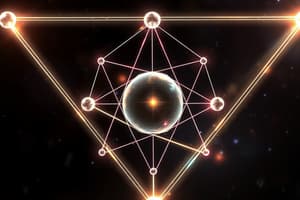Podcast
Questions and Answers
Chirality refers to the property of a molecule or ion that can be superposed on its mirror image by any combination of rotations and translations.
Chirality refers to the property of a molecule or ion that can be superposed on its mirror image by any combination of rotations and translations.
False (B)
A homogeneous mixture of enantiomers in equal parts is called racemic and usually differs chemically and physically from the pure enantiomers.
A homogeneous mixture of enantiomers in equal parts is called racemic and usually differs chemically and physically from the pure enantiomers.
True (A)
Enantiomers are mirror images of each other and are often distinguished as either 'right-handed' or 'left-handed' by their absolute configuration.
Enantiomers are mirror images of each other and are often distinguished as either 'right-handed' or 'left-handed' by their absolute configuration.
True (A)
Chiral molecules always have opposite chemical properties when reacting with other chiral compounds.
Chiral molecules always have opposite chemical properties when reacting with other chiral compounds.
Chirality is a geometric property that cannot be superposed on its mirror image by any combination of rotations, translations, and some conformational changes.
Chirality is a geometric property that cannot be superposed on its mirror image by any combination of rotations, translations, and some conformational changes.
Chiral molecules or ions cannot be superposed on their mirror image by any combination of rotations, translations, and some conformational changes.
Chiral molecules or ions cannot be superposed on their mirror image by any combination of rotations, translations, and some conformational changes.
Enantiomers of a chiral molecule have the same chemical properties when reacting with other chiral compounds.
Enantiomers of a chiral molecule have the same chemical properties when reacting with other chiral compounds.
A mixture of enantiomers in equal parts is called racemic and usually differs chemically and physically from the pure enantiomers.
A mixture of enantiomers in equal parts is called racemic and usually differs chemically and physically from the pure enantiomers.
Chirality is derived from the Ancient Greek word 'hand' and is a geometric property.
Chirality is derived from the Ancient Greek word 'hand' and is a geometric property.
Chiral molecules will always have opposite optical activities.
Chiral molecules will always have opposite optical activities.
Flashcards are hidden until you start studying




